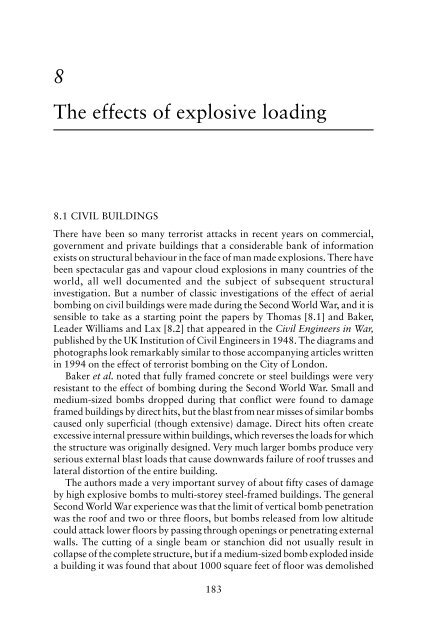A History of Research and a Review of Recent Developments
A History of Research and a Review of Recent Developments
A History of Research and a Review of Recent Developments
You also want an ePaper? Increase the reach of your titles
YUMPU automatically turns print PDFs into web optimized ePapers that Google loves.
8<br />
The effects <strong>of</strong> explosive loading<br />
8.1 CIVIL BUILDINGS<br />
There have been so many terrorist attacks in recent years on commercial,<br />
government <strong>and</strong> private buildings that a considerable bank <strong>of</strong> information<br />
exists on structural behaviour in the face <strong>of</strong> man made explosions. There have<br />
been spectacular gas <strong>and</strong> vapour cloud explosions in many countries <strong>of</strong> the<br />
world, all well documented <strong>and</strong> the subject <strong>of</strong> subsequent structural<br />
investigation. But a number <strong>of</strong> classic investigations <strong>of</strong> the effect <strong>of</strong> aerial<br />
bombing on civil buildings were made during the Second World War, <strong>and</strong> it is<br />
sensible to take as a starting point the papers by Thomas [8.1] <strong>and</strong> Baker,<br />
Leader Williams <strong>and</strong> Lax [8.2] that appeared in the Civil Engineers in War,<br />
published by the UK Institution <strong>of</strong> Civil Engineers in 1948. The diagrams <strong>and</strong><br />
photographs look remarkably similar to those accompanying articles written<br />
in 1994 on the effect <strong>of</strong> terrorist bombing on the City <strong>of</strong> London.<br />
Baker et al. noted that fully framed concrete or steel buildings were very<br />
resistant to the effect <strong>of</strong> bombing during the Second World War. Small <strong>and</strong><br />
medium-sized bombs dropped during that conflict were found to damage<br />
framed buildings by direct hits, but the blast from near misses <strong>of</strong> similar bombs<br />
caused only superficial (though extensive) damage. Direct hits <strong>of</strong>ten create<br />
excessive internal pressure within buildings, which reverses the loads for which<br />
the structure was originally designed. Very much larger bombs produce very<br />
serious external blast loads that cause downwards failure <strong>of</strong> ro<strong>of</strong> trusses <strong>and</strong><br />
lateral distortion <strong>of</strong> the entire building.<br />
The authors made a very important survey <strong>of</strong> about fifty cases <strong>of</strong> damage<br />
by high explosive bombs to multi-storey steel-framed buildings. The general<br />
Second World War experience was that the limit <strong>of</strong> vertical bomb penetration<br />
was the ro<strong>of</strong> <strong>and</strong> two or three floors, but bombs released from low altitude<br />
could attack lower floors by passing through openings or penetrating external<br />
walls. The cutting <strong>of</strong> a single beam or stanchion did not usually result in<br />
collapse <strong>of</strong> the complete structure, but if a medium-sized bomb exploded inside<br />
a building it was found that about 1000 square feet <strong>of</strong> floor was demolished<br />
183


